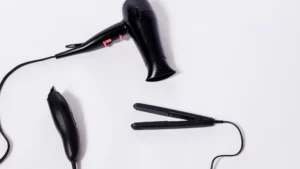Undergoing a hair transplant is a significant decision for those looking to regain their confidence and restore their hairline. However, the journey doesn’t end with the procedure itself.
My name is Emma Wright, your hair transplant and hair restoration specialist. Today, we’ll be looking at how to ash hair after hair transplant. One of the many things to avoid after a hair transplant is washing hair immediately after the transplant.
Proper aftercare, especially when it comes to washing your hair, is crucial for the success and longevity of your newly transplanted hair. So, when then is the right time to wash hair after a hair transplant? Good question.
In this comprehensive guide, we will delve into the step-by-step process of how to wash your hair after a hair transplant, ensuring optimal healing and the best possible results.
Understanding the Importance of Post-Transplant Hair Care
After a hair transplant, your scalp becomes particularly sensitive and prone to infections if not cared for properly. Washing your hair correctly is essential for removing blood clots, scabs, and debris from the scalp without damaging the newly transplanted follicles.
Following the recommended washing routine helps promote healing, prevents infection, and encourages healthy hair growth.
Step-by-Step Guide to Washing Your Hair After a Hair Transplant
- Wait for the Right Time: Your surgeon will provide specific instructions on when you can start washing your hair after the transplant. Typically, you’ll need to wait at least 48 hours before washing to allow the grafts to settle.
- Gather Supplies: Before you begin, ensure you have all the necessary supplies on hand. You’ll need a mild, sulfate-free shampoo, a gentle conditioner, lukewarm water, a cup or spray bottle, and a clean, soft towel.
- Prepare the Shampoo Mixture: Dilute your shampoo with water to create a gentle, foamy solution. Mix approximately one part shampoo with three parts water in a cup or spray bottle.
- Wet Your Scalp: Gently wet your scalp with lukewarm water. Avoid using hot water, as it can irritate the scalp and disrupt the healing process.
- Apply the Shampoo: Pour a small amount of the diluted shampoo onto your fingertips and apply it to the recipient area with gentle, circular motions. Be extremely careful not to dislodge the grafts or apply excessive pressure.
- Massage the Scalp: Using your fingertips, lightly massage the shampoo into your scalp for about 30 seconds. Focus on the areas where the grafts were transplanted, but avoid rubbing or scrubbing vigorously.
- Rinse Thoroughly: Rinse your scalp thoroughly with lukewarm water, ensuring that all traces of shampoo are removed. Use a cup or spray bottle to control the flow of water and minimize direct pressure on the scalp.
- Apply Conditioner (Optional): If your surgeon approves, you can apply a small amount of conditioner to the mid-lengths and ends of your hair, avoiding the scalp. Leave the conditioner on for a few minutes before rinsing it out thoroughly.
- Pat Dry Your Hair: Gently pat your scalp and hair with a clean, soft towel to remove excess water. Avoid rubbing or scratching your scalp, as this can cause irritation and damage to the grafts.
- Let Your Hair Air Dry: Allow your hair to air dry naturally. Avoid using a hairdryer or any styling products for the first few days after the transplant, as they can irritate the scalp and interfere with the healing process.
- Repeat as Directed: Follow your surgeon’s instructions regarding the frequency of hair washing after the transplant. Typically, you’ll need to wash your hair daily or every other day using the gentle shampoo provided.
Additional Tips for Proper Hair Washing After a Transplant
- Use a Mild Shampoo: Opt for a sulfate-free, pH-balanced shampoo that is gentle on the scalp and does not contain harsh chemicals or fragrances.
- Avoid Hot Water: Stick to lukewarm or cool water when washing your hair, as hot water can strip the scalp of its natural oils and cause irritation.
- Be Gentle: Handle your hair and scalp with care, avoiding any unnecessary rubbing, scratching, or pulling. Use your fingertips to massage the shampoo gently into your scalp.
- Patience is Key: Allow ample time for your hair to heal and for the transplanted follicles to take root. Avoid rushing the process or attempting to style your hair too soon after the transplant.
- Follow Your Surgeon’s Instructions: Every individual and every transplant is unique, so it’s essential to follow the specific guidelines provided by your surgeon for optimal results.
How Often to Wash Hair After Hair Transplant
Determining how often to wash your hair after a hair transplant is crucial for promoting proper healing and ensuring the best possible outcomes. While individual recommendations may vary based on factors such as the type of transplant, the extent of the procedure, and your surgeon’s specific instructions, there are some general guidelines to consider.
- Follow Your Surgeon’s Recommendations: Your surgeon will provide you with personalized post-operative care instructions, including guidance on how often to wash your hair. It’s essential to follow these instructions diligently, as they are tailored to your unique needs and circumstances.
- Initial Washing Schedule: In the immediate aftermath of your hair transplant surgery, your surgeon may recommend waiting a certain period before washing your hair for the first time. This waiting period allows the newly transplanted grafts to settle and reduces the risk of dislodging them during washing. Typically, patients are advised to wait at least 24 to 48 hours before initiating the first hair wash.
- Gradual Increase in Frequency: After the initial waiting period, your surgeon may recommend gradually increasing the frequency of hair washing over time. This gradual approach allows your scalp to adjust to the washing process while minimizing the risk of irritation or damage to the newly transplanted grafts.
- Daily Washing: In many cases, surgeons may recommend washing your hair daily starting a few days after the initial waiting period. Daily washing helps to keep the scalp clean, remove any scabs or crusts that may have formed, and create an optimal environment for healing and hair growth.
- Use Mild, Sulfate-Free Shampoo: When washing your hair after a transplant, it’s essential to use a mild, sulfate-free shampoo that is gentle on the scalp and hair follicles. Harsh chemicals can irritate the scalp and impede the healing process, so opt for gentle, non-abrasive products recommended by your surgeon.
- Avoid Overwashing: While it’s crucial to keep your scalp clean and free of debris, overwashing can strip the scalp of its natural oils and cause dryness or irritation. If you have concerns about washing your hair too frequently, discuss them with your surgeon to determine the best approach for your specific case.
- Listen to Your Body: Pay attention to how your scalp feels after each hair wash. If you experience any discomfort, redness, or irritation, it may be a sign that you are washing your hair too frequently or using products that are too harsh. In such cases, adjust your washing frequency and products accordingly, and consult your surgeon if necessary.

When to Wash Hair Normally After Hair Transplant
Determining when to resume your regular hair-washing routine after a hair transplant depends on several factors, including the type of transplant, the extent of the procedure, and your surgeon’s specific instructions.
While individual recommendations may vary, there are some general guidelines to consider:
- Initial Waiting Period: After a hair transplant surgery, it’s typical for surgeons to recommend waiting a specific period before washing your hair for the first time. This waiting period allows the newly transplanted grafts to settle and reduces the risk of dislodging them during washing. Surgeons often advise waiting at least 24 to 48 hours before initiating the first hair wash, although this may vary based on individual circumstances.
- Follow Surgeon’s Recommendations: Your surgeon will provide you with personalized post-operative care instructions, including guidance on when to resume your regular hair-washing routine. It’s crucial to follow these instructions diligently, as they are tailored to your unique needs and circumstances. Your surgeon may recommend gradually transitioning back to your normal hair-washing routine over time.
- Monitoring Healing Progress: As your scalp heals following the transplant surgery, you should monitor the progress of healing and any potential complications. Pay attention to any signs of infection, excessive redness, swelling, or discomfort, and notify your surgeon if you have any concerns.
- Gentle Washing: When you do resume your regular hair-washing routine, it’s essential to be gentle and avoid any harsh rubbing or scrubbing. Use a mild, sulfate-free shampoo and lukewarm water to wash your hair, and avoid hot water or products containing harsh chemicals that could irritate the scalp.
- Avoid Overwashing: While it’s essential to keep your scalp clean and free of debris, overwashing can strip the scalp of its natural oils and disrupt the healing process. Follow your surgeon’s recommendations regarding the frequency of hair washing, and avoid washing your hair more frequently than advised.
- Gradual Transition: If you’re unsure about when to resume your regular hair-washing routine or if you have concerns about potential complications, consult your surgeon for guidance. They can provide personalized recommendations based on your specific case and help you navigate the post-operative recovery process effectively.
Best Shampoo After Hair Transplant
Choosing the best shampoo after a hair transplant is crucial for promoting healing, maintaining scalp health, and ensuring the longevity of your transplanted hair.
Here are some key factors to consider when selecting a shampoo:
- Mild and Gentle Formula: Opt for a shampoo with a mild and gentle formula that is specifically designed for post-transplant care. Look for shampoos that are free from harsh chemicals, sulfates, parabens, and artificial fragrances, as these ingredients can irritate the scalp and impede the healing process.
- Sulfate-Free: Sulfates are commonly found in many commercial shampoos and can strip the scalp of its natural oils, leading to dryness and irritation. Choose a sulfate-free shampoo to maintain scalp moisture and prevent excessive drying, especially during the early stages of healing after a hair transplant.
- pH-Balanced: Look for a shampoo that is pH-balanced to match the natural pH of the scalp. A pH-balanced shampoo helps to maintain the scalp’s natural acidity, which is essential for overall scalp health and preventing irritation or inflammation.
- Botanical and Natural Ingredients: Consider shampoos that contain botanical extracts and natural ingredients known for their soothing and nourishing properties. Ingredients such as aloe vera, chamomile, green tea, and coconut oil can help calm the scalp, reduce inflammation, and promote healing.
- Non-Medicated: Avoid medicated shampoos containing ingredients such as ketoconazole or coal tar, unless specifically recommended by your surgeon or dermatologist for treating a specific scalp condition. While these ingredients may be effective for certain scalp issues, they can be too harsh for use immediately after a hair transplant.
- Moisturizing: Choose a shampoo that provides adequate moisture to the scalp and hair without weighing it down. Look for moisturizing ingredients such as glycerin, panthenol (provitamin B5), and hyaluronic acid to help hydrate the scalp and hair follicles.
- Fragrance-Free (Optional): Fragrances added to shampoos can sometimes cause irritation, especially for individuals with sensitive skin or allergies. If you have a history of skin sensitivity, consider opting for a fragrance-free shampoo to minimize the risk of irritation.
- Consult with Your Surgeon: Before selecting a shampoo for post-transplant care, consult with your surgeon or dermatologist for personalized recommendations based on your specific needs and the type of transplant procedure you underwent. They can provide guidance on the most suitable shampoo for your scalp condition and help you navigate the post-operative recovery process effectively.
Remember that everyone’s scalp is unique, so what works well for one person may not necessarily work for another. It’s essential to choose a shampoo that is compatible with your scalp type, preferences, and any specific recommendations provided by your healthcare provider.
By selecting a gentle, sulfate-free, and pH-balanced shampoo containing natural ingredients, you can support the healing process and maintain scalp health after a hair transplant.
Conclusion
Properly washing your hair after a hair transplant is a crucial aspect of post-operative care that should be considered. By following the step-by-step guide outlined in this article and adhering to your surgeon’s instructions, you can ensure the best possible outcomes and enjoy the full benefits of your hair restoration journey.
Remember, patience and diligence are key to achieving the healthy, natural-looking hair you desire.














